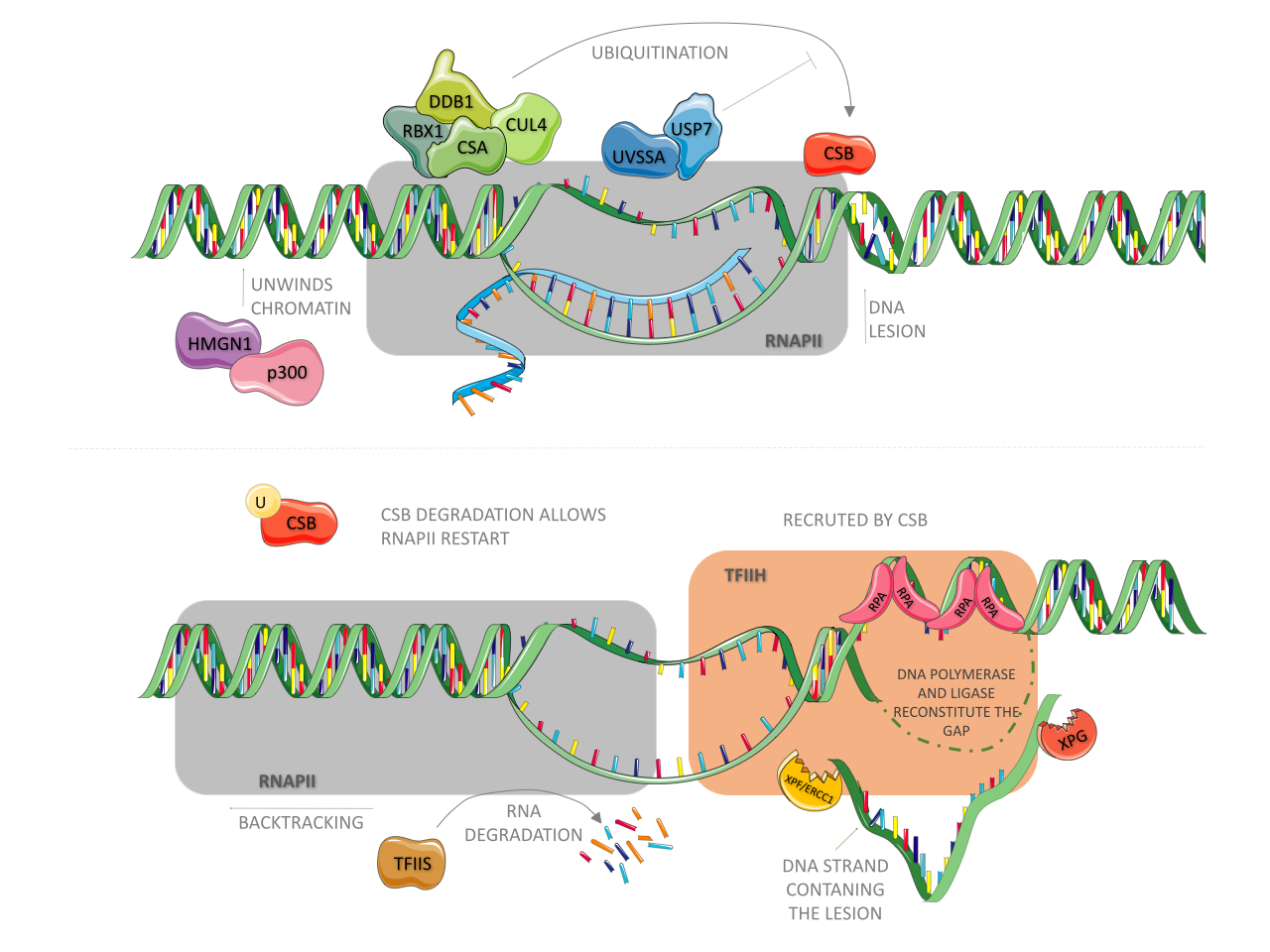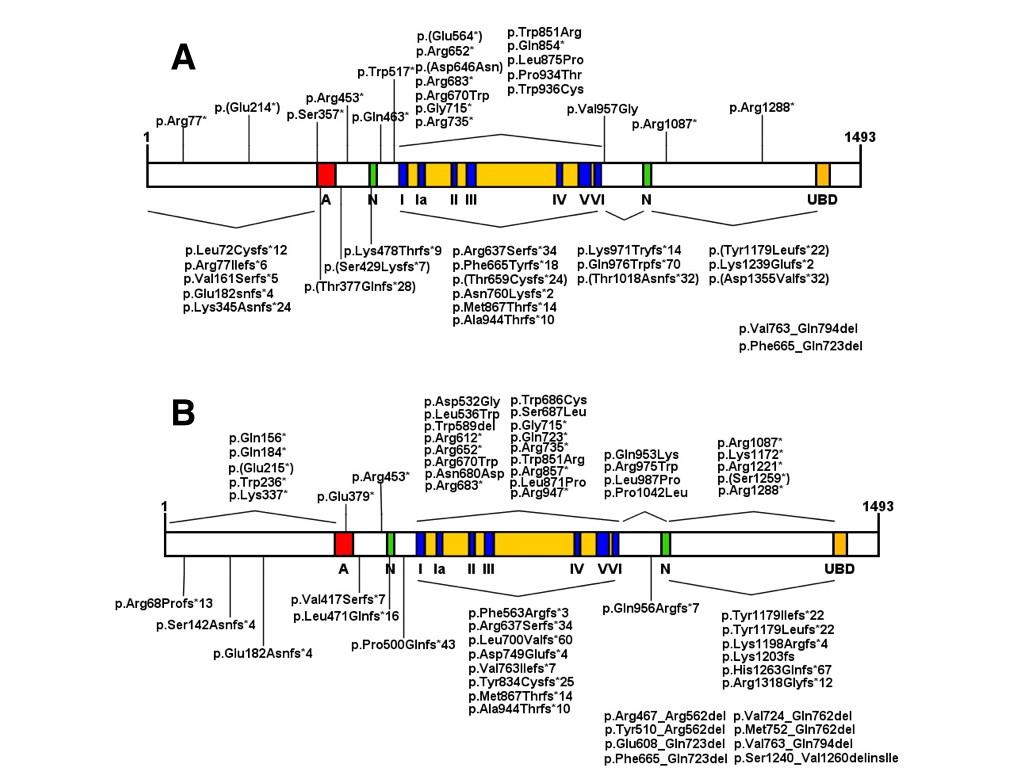| Csbm/m
|
C57BL/6J |
Mild, progressive neurodegeneration with no behavioral phenotype, mild astro and microgliosis, hearing loss associated with loss of neurosensorial cells, late retinal degeneration |
Increased metabolism and mitochondrial numbers, Progressive lipodistrophy |
> 2 years |
Increased skin cancer predisposition after UV exposure |
Van der Horst et al., 1997; Jaarsma et al., 2011 |
| Csa-/-
|
C57BL/6J |
Mild, progressive neurodegeneration with no behavioral phenotype, mild astro and microgliosis, hearing loss associated with loss of neurosensorial cells |
Increased metabolism |
> 2 years |
Increased skin cancer predisposition after UV exposure |
van der Horst et al., 2002; Gorgels et al, 2007; Jaarsma et al., 2011; Brace et al., 2016 |
| Csbm/m/Xpa-/-
|
C57BL/6J; CBA/C57BL6/CD-1/129Ola hybrid |
Profound early postnatal ataxia, abnormal cerebellar development and degeneration, loss of purkinjecells, progressive neurological dysfunction, motor coordination problems, early retinal degeneration |
Severe post-natal growth deficiency, Severe lipodistrophy, decreased oxidative metabolism |
3 weeks |
Suppression of the GH/IGF1 somatotroph axis increased antioxidant responses, hypoglycemia |
Murai et al., 2001, van der Pluijm et al., 2007; Jaarsma et al., 2011 |
| Csb-/- / Xpac/- CamKIIα-Cre |
C57BL/6J |
Progressive neurological dysfunction, Purkinje cell death, neurodegeneration, motor coordination problems starting at 6 months |
Weight reduction in adult animals |
90 weeks |
- |
Jaarsma et al., 2011 |
| Csbm/m/Xpc-/-
|
C57BL/6J, 129Ola/C57BL/6J hybrid |
Depletion of purkinje cells, neurodegeneration in cerebellum, motor coordination problems, dysmielination |
Severe post-natal growth deficiency, Severe lipodistrophy |
3 weeks |
- |
van der Pluijm et al., 2007; Laposa et al., 2007; Revet et al., 2012 |
| Csbm/m/Ogg1-/-
|
C57BL/6J |
No neurological phenotype has been observed |
Not described |
> 2 years |
Accumulation of oxidative stress related DNA damage and mutations in various tissues |
Osterod et al., 2002; Pastoriza-Gallego et al., ?2007; FusserFusser M, Nesse GJ, Khobta A, Xia N, Li H, Klungland A and Epe B (2011) Spontaneous mutagenesis in csbm/mogg1-/- mice is attenuated by dietary resveratrol. Carcinogenesis 32:80–85.et al., 2011 |
| Csa-/-/Xpa-/-
|
C57BL/6J |
Early, progressive neurological dysfunction, dysmyelination, abnormal cerebellar development and degeneration, motor coordination problems, severe astro and microgliosis |
Post-natal growth deficiency, increased metabolism, severe lipodistrophy, senescence of fat tissue, no fat tissue inflammation |
20 weeks |
- |
Brace et al., 2013; Brace et al., 2016 |
| Xpg-/-
|
C57BL/6J |
Purkinje cell degeneration, cerebellum neurodegeneration |
Severe post-natal growth deficiency, Severe lipodistrophy |
3 weeks |
Abnormalities of the gastro-intestinal tract, early fibroblast senescence |
Harada et al., 1999; Sun et al., 2001; Barnhoorn et al., 2014 |
| Xpg-/-
|
C57BL6/FVB F1 hybrid |
Purkinje cell death, neurodegeneration, motor coordination problems axonal spheroids, severe astrogliosis |
Post-natal growth deficiency, loss of subcutaneous fat |
18 weeks |
Skeletal abnormalities, mild anisokaryosis, increased mean nuclear size of liver cells, supression of GH/IGF1 axis |
Barnhoorn et al, 2014; Vermeij, 2016 |
| Ercc1-/-
|
Hybrid C57Bl/6/129 |
Early, progressive neurological dysfunction, neurodegeneration and motor coordination problems |
Severe post-natal growth deficiency, decreased oxidative metabolism, severe lipodistrophy, increase in fat tissue inflammation |
3 weeks |
Liver nuclear abnormalities, p53 upregulation in liver and kidney, early fibroblast senescence |
Mcwhir et al., 1993, Weeda et al., 1997 |
| Ercc1Δ/-
|
C57Bl6J/FVB hybrid |
Early, progressive neurological dysfunction, myelin abnormalities, abnormal cerebellar development and degeneration, Motor coordination problems, severe astro and microgliosis |
Post-natal growth deficiency, decreased oxidative metabolism, severe lipodistrophy, increase in fat tissue inflammation |
22-25 weeks |
Early fibroblast and vascular tissue senescence, reduced bone density |
Weeda et al., 1997; NevedomskayaNevedomskaya E, Meissner A, Goraler S, De Waard M, Ridwan Y, Zondag G, Van Der Pluijm I, Deelder AM and Mayboroda OA (2010) Metabolic profiling of accelerated aging ERCC1d/- mice. J Proteome Res 9:3680–3687.et al., 2010; de Waard et al., 2010; DurikDurik M, Kavousi M, van der Pluijm I, Isaacs A, Cheng C, Verdonk K, Loot AE, Oeseburg H, Bhaggoe UM, Leijten F et al. (2013) Nucleotide Excision DNA Repair is Associated with Age-Related Vascular Dysfunction. Circulation 126:468–478.et al., 2012; Vermeij et al., 2016; |

 Thumbnail
Thumbnail
 Thumbnail
Thumbnail
 Thumbnail
Thumbnail


